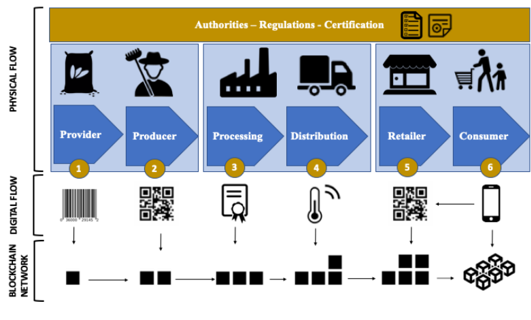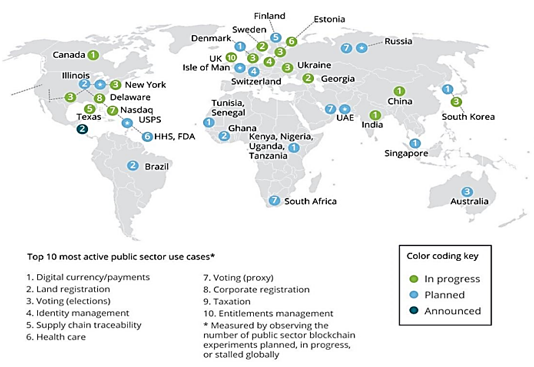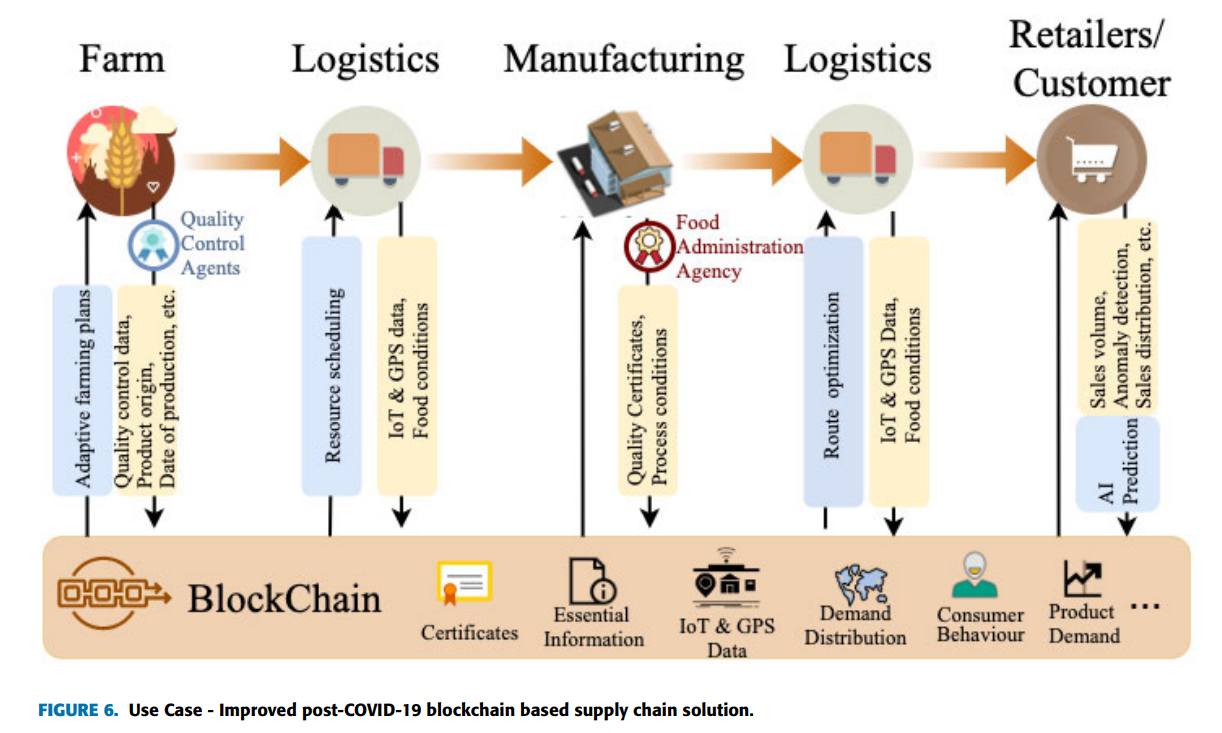- Visibility 147 Views
- Downloads 18 Downloads
- DOI 10.18231/j.agems.2024.005
-
CrossMark
- Citation
Agriculture meets blockchain: Innovations in food traceability
Introduction
The intricate mechanism in charge of distributing agricultural goods throughout the market is known as the agricultural supply chain. These days, the transparency, quick uses, and comparatively low transaction costs of technology might be advantageous for food security.[1] Worldwide banking institutions often leverage the blockchain's strong and decentralized capabilities, but it is simple to extend to contracts and other processes like supply chain tracking on a worldwide scale.[2] The modern food industry's globalization has led to the development of intricate networks of cooperation that connect producers, middlemen, and final consumers across vast distances.[2]
These networks, which are designed to track a product from its core ingredients through its manufacturing and exchange, until its consumption, are sometimes referred to as food supply chains.[3] Regarding food supply chains, some good progress has been made in implementing blockchain technology, with examples showing how it may be used to guarantee food quality, prevent fraud, and track its origin. In this article, we list a number of difficulties that are frequently encountered in regular food supply chains and discuss current solutions. Given the sensitivity of the controlled products, we stress the significance of managing a food supply chain in a transparent and safe manner. Finally implementing blockchain technology aid in the handling of the challenges and how blockchain adopting technology can enhance the management of food supply chains. [4]
Food supply chain
The global food chain is characterized by a high degree of actor diversity, involving a wide range of entities including farmers, shipping businesses, merchants, wholesalers, distributors, and grocery stores. The following describes the key stages of a typical agri-food supply chain. [5]
Production- All agricultural practices carried out on the farm are included in this phase. To raise crops and livestock farmers employ organic and raw materials such as seeds, fertilizers, animal breeds, and feeds. For an instance, we may have one or more harvests or yields throughout the year, contingent upon the cycles of animal production and cultivations.[6]
Processing- This stage involves turning a primary product—wholly or partially—into one or more secondary products. After that, there would be the packaging step. During this phase, each package may be individually identifiable by a production batch code that contains details on the manufacturing day and the raw material list.[6]
Distribution- The product is made available for distribution after it has been packaged and labelled. Delivery times may be restricted to a specific range and may include a step for product storage, depending on the product.[6]
Retailing- Products are delivered to retailers at the end of distribution, who handle the product sales (Retailers). The client, who would purchase the product, would be the chain's final user.[6]
Consumption- The final link in the chain is the consumer, who purchases the good and requests traceable information about the nation of origin, manufacturing processes, and quality standards, among other things.

A simplified representation of the food supply system's key components and stakeholders can be seen in the picture above. To this day, the current system is unreliable and inefficient.[7]
A lot of paper work and complexity go into the settlement procedures that underpin the trade of goods, making them opaque and fraught with danger for both buyers and sellers. Because transactions are susceptible to fraud, middlemen become engaged, raising the transfer’s total cost.[8]
Food security
A state of food security is one in which "all people, at all times, have physical, social, and economic access to sufficient, safe, and nutritious food that meets their dietary needs and food preferences for an active and healthy life," according to the Food and Agriculture Organization (FAO). Under humanitarian catastrophes brought on by natural disasters, violent political and ethnic conflicts, etc., achieving this goal has proven to be incredibly difficult. It is believed that blockchain technology would enable transparent international aid delivery, remove middlemen from the delivery process, make records and assets traceable and accessible, and ultimately enable more timely and effective responses to humanitarian crises.[9]
Food Safety
Food safety refers to the practice of handling, preparing, and storing food in a hygienic manner to minimize the spread of illnesses among people. Food safety and quality control have grown more challenging in an era of expanding global trade flows.[10] The Centers for Disease Control and Prevention (CDC) asserts that food contamination results in 48 million illnesses and 3,000 deaths in the United States each year.[11] Blockchain technology may offer a useful way to address the acute need for improved food traceability in terms of safety and transparency this year[12] Among the first businesses to adopt blockchain technology and integrate it into their supply chains are Walmart and Kroger. Initially, they worked on case studies that highlighted Mexican mangoes and Chinese pork.[13], [14]
Supervision and Management
Blockchain technology can also be used to improve the efficacy of management and oversight in the food supply chain by implementing a credit evaluation system. Additionally, it can be used to enhance the oversight of global accords that are pertinent to agriculture, such the Paris Climate Change Agreement and agreements made by the World Trade Organization.[15] Additionally, blockchain-based contracts might lessen the labour abuse in the agricultural sector by safeguarding employees with short-term contracts and employment connections in the field.[16] The government can more easily regulate taxation and payment fairness when labour agreements are included into the blockchain. Coca-Cola has made an effort to use blockchain technology to identify forced labour in the sugarcane industry.[17] In order to guarantee the safety and quality of rice throughout transit, blockchain technology was also utilized to record events occurring in the rice value chain.[18] Ultimately, blockchain technology has the potential to regulate shared resources like water and electricity and stop market speculation.[19]
Potential Benefits
A decentralized ledger facilitates the connection of remote inputs, suppliers, producers, customers, and regulators as well as those operating under various programs, laws and applications in order to increase traceability in value chains. Through the use of smart contracts, producers can create more flexible and scalable firms at a reduced cost, increasing the overall efficiency of manufacturing services. [20] Blockchain offers the ability to track environmental and social responsibility, enhance provenance data, enable mobile payments, credits, and financing, lower transaction costs, and provide safe and reliable real-time supply chain transaction management [21] In the industrialized world, the environmental and financial viability of smaller farms has historically been constrained by issues like unjust pricing and the power of large corporations. Fairer pricing along the entire value chain could be facilitated by blockchain.[22] Additionally, as consumers are the market's primary driver, there may be a benefit to raising consumer empowerment and awareness. A greater vision among consumers would boost pressure on food producers to use more transparent, sustainable, safe, and equitable methods. Blockchain technology appears to have a beneficial impact on consumers' purchase decisions since consumers are overwhelmed by the quantity and complexity of certification labels.[23]
Governance and Sustainability
It is still necessary to evaluate the long-term effects of blockchain on social issues, economic sustainability, and governance. Some experts have noted that supply chains may face new difficulties as a result of the immutability of data contained in blockchains and an abundance of information openness.[24] Permanent data visibility could, on the one hand, exacerbate privacy concerns and ultimately increase the ability of centralized entities to monitor citizens. However, big businesses may use permissioned and private blockchains, which could support oligopolistic behaviour [25] In conclusion, it is important to note that food product quality parameters—which the blockchain makes more transparent for the consumer to see—often justify higher pricing. Governance is crucial in this regard as well because food scammers frequently target them.[26]
Digital Gap Between Developed and Developing Countries
Subsistence is a top priority for farmers in many regions of the world, therefore they must focus all of their efforts on farming and lack technological know-how. It is challenging to locate the high-level computing equipment needed for blockchain technology in poor nations. [27] Therefore, it appears that the developed and underdeveloped worlds differ in terms of digital literacy and blockchain technology access. [28]

It appears that developed areas are where the majority of ongoing tests take place. Taking into account that blockchain could present a significant chance for small farmers, developmental assistance should concentrate on providing technology transfer and training to farmers in developing nations in order to actually address the conditions that impede their socioeconomic advancement.
|
Supply chain participants |
Current limitations |
Blockchain impact |
|
|
Producer |
Lack of ability to prove the origin and quality metrics of products transparently |
Benefits from increased trust of keep track of the production raw material and value chain from producer to consumer |
|
|
Manufacturer |
Limited ability to monitor the product to the final destination.Limited capabilities of checking quality measured from raw material. |
Added value from shared information system with raw material suppliers and distribution network |
|
|
Distributor |
Custom tracking systems with poor collaboration capabilities. Limited certification ability and trust issues |
Ability to have proof-of-location and conditions certifications registered in the ledger |
|
|
Wholesaler |
Lack of trust and certification of the products path |
Ability to check the origin of the goods and the transformation conditions |
|
|
Retailer |
Lack of trust and certification of the products path tracking of products between consumers and wholesales |
Ability to handle effectively the return of malfunctioning products |
|
|
Consumer |
Lack of trust regarding the compliance of the product with respect to origin ,quality and compliance of the product to the specified standards and origin |
Full and transparent view on the product origin and its whole journey from raw material to final, purchased product |
Technical Challenges and Design Decisions
There are a lot of design choices that influence the current and future blockchains. These choices have an impact on how the blockchain functions by reducing its flexibility and in some cases make blockchain solutions less effective than other traditional centralized approaches.[31] It concerns about privacy of customers. The users can be identified by their public keys because all transactions are recorded on a single ledger. This technology promotes openness and fosters trust as so many players in the food supply ecosystem are in direct competition with one another, anonymity is especially crucial. Blockchain systems currently face the difficulty of retaining a certain amount of privacy.
An illustration of Essential food Supply in Post-covid-19 Pandemic
Despite the fact that the agricultural supply chain has numerous blockchain technologies in place of the ongoing COVID-19 epidemic has caused a severe issue for the world's food supply. Due to the supply network disturbances throughout this time, there was a scarcity of basic foods including rice, fresh vegetables, flour, and eggs which has made suppliers and consumers anxious. Restoring normalcy to the operations of food product supply requires weeks, if not months, of resource allocation adjustments. To address the asymmetric information problem and improve the situation, more development of blockchain-based supply chain solutions is needed. We can take away from the global food supply disruption caused by COVID-19 at least three important lessons. The primary one is that all parties involved require correct information that is current and up-to-date (b) In order to produce prompt and pertinent solutions in real-time, there needs to be more effective worldwide coordination within stakeholders. (c) Time-consuming bureaucracy procedures require efficient processes. These insights spur us to improve the current blockchain-based supply chain systems so that we can continue to offer superior services.
A better blockchain-based supply chain system that can be implemented in the post-COVID-19 era is depicted in [Figure 3]. For a more effective system, machine learning techniques will be smoothly combined with blockchain technology. The provenance of products, together with pertinent data and certifications, is recorded in the blockchain for traceability, just like in other current blockchain systems.

Conclusion
The application of blockchain technology in numerous projects create a reliable and trustworthy environment for transparent, sustainable food production and distribution while incorporating important stakeholders into the supply chain. Though there are still a great deal of problems that require solution. The technology that have been outlined in this article still require evaluation for their economic viability and the results of these economic studies are anticipated to have an impact on the adoption of blockchain technology in the food supply chain in the future. [31] In conclusion, blockchain technology is a promising technology for a transparent food supply chain nevertheless with all the numerous obstacles and difficulties still need to overcome before it can become widely accepted by farmers and food supply systems. In future, it would be evident whether how these obstacles can prevail over the public and private initiatives to establish blockchain technology as a safe, dependable, and transparent means of guarantee of integrity and safety of food. Ongoing research is about ,How blockchain is integrated with other cutting-edge technologies (big data, robotics, IoT, RFID, NFC, hyperspectral imaging, etc.) to increase automation of food supply systems and improve transparency and traceability which is an exciting area of research.[32]
Source of Funding
None.
Conflict of Interest
None.
References
- K Leng, Y Bi, JL Fu. Van Nieuwenhuyse I, Research on agricultural supply chain system with double chain architecture based on blockchain technology. Future Gen Comp Syst 2018. [Google Scholar]
- JF Galvez, JC Mejuto, JS Gandara. Future challenges on the use of blockchain for food traceability analysis. TrAC Trends Anal Chem 2018. [Google Scholar]
- P Katsikouli, AS Wilde, N Dragoni, HH Jensen. On the benefits and challenges of blockchains for managing food supply chains. J Sci Food Agricul 2021. [Google Scholar]
- MM Aung, YS Chang. Traceability in a food supply chain: Safety and quality perspectives. Food control 2014. [Google Scholar]
- MP Caro, MS Ali, M Vecchio, R Giaffreda. Blockchain-based traceability in Agri-Food supply chain management: A practical implementation. 2018. [Google Scholar]
- A Kamilaris, A Fonts, FX Prenafeta-Boldύ. The rise of blockchain technology in agriculture and food supply chains. . Trends Food Sci Technol 2019. [Google Scholar]
- M Tripoli, J Schmidhuber. . Emerging Opportunities for the Application of Blockchain in the Agri-food Industry 2018. [Google Scholar]
- M Lierow, C Herzog, P Oest. . Blockchain: The Backbone of Digital Supply Chains Oliver Wyman 2017. [Google Scholar]
- A Tech. How blockchain technology is enabling international aid to be delivered transparently. 2017. [Google Scholar]
- M Creydt, M Fischer. Blockchain and more-Algorithm driven Food Traceability. Food Control 2019. [Google Scholar]
- . Burden of Foodborne Illness: Findings. 2018. [Google Scholar]
- M Tripoli, J Schmidhuber. Emerging Opportunities for the Application of Blockchain in the Agri-food Industry. 2018. [Google Scholar]
- . . How Blockchain Could Transform Food Safety 2017. [Google Scholar]
- R Kamath. Food traceability on blockchain: Walmart’s pork and mango pilots with IBM. The JBBA 2018. [Google Scholar]
- D Mao, F Wang, Z Hao, H Li. Credit evaluation system based on blockchain for multiple stakeholders in the food supply chain. Int J Environ Res Publ Health 2018. [Google Scholar]
- A Pinna, S Ibba. A blockchain-based Decentralized System for proper handling of temporary Employment contracts. Sci Inf Conference 2018. [Google Scholar]
- GC Dreyfuss. Coca-Cola, U.S. State Dept to use blockchain to combat forced labor. 2018. [Google Scholar]
- MV Kumar, NCS Iyengar. A framework for Blockchain technology in rice supply chain management. Adv Sci Technol Lett 2017. [Google Scholar]
- A Poberezhna. Addressing Water Sustainability With Blockchain Technology and Green Finance. 2018. [Google Scholar]
- Z Li, WM Wang, G Liu, L Liu, J He, GQ Huang. Toward open manufacturing: A cross-enterprises knowledge and services exchange framework based on blockchain and edge computing. Indu Manag Data Sys 2018. [Google Scholar]
- HL Lee, H Mendelson, S Rammohan, A Srivastava. Technology in Agribusiness: Opportunities to drive value. 2017. [Google Scholar]
- . Demystifying Blockchain for Water Professionals. 2018. [Google Scholar]
- F Sander, J Semeijn, D Mahr. The acceptance of blockchain technology in meat traceability and transparency. Int J Physical Distribu Logistics Manag 2018. [Google Scholar]
- S Pearson, D May, G Leontidis, M Swainson, S Brewer, L Bidaut. Are Distributed Ledger Technologies the panacea for food traceability?. Glob Food Sec 2019. [Google Scholar]
- M Creydt, M Fischer. Blockchain and more-Algorithm driven Food Traceability. Food Control 2019. [Google Scholar]
- G Zhao, S Liu, C Lopez, H Lu, S Elgueta, H Chen. Blockchain technology in agri-food value chain management: A synthesis of applications, challenges and future research directions. Comp Indus 2019. [Google Scholar]
- A Maru, D Berne, JD Beer, PG Ballantyne, V Pesce, S Kalyesubula. Digital and data-driven agriculture: Harnessing the power of data for smallholders. Glob Forum Agricul Res Innov 2018. [Google Scholar]
- J Killmeyer, M White, B Chew. Will blockchain transform the public sector?. 2017. [Google Scholar]
- A Litke, D Anagnostopoulos, T Varvarigou. Blockchains for supply chain management: architectural elements and challenges towards a global scale deployment. Logistics 2019. [Google Scholar]
- S Keesstra, G Mol, J De Leeuw, J Okx, M De Cleen, S Visser. Soil-Related Sustainable Development Goals: FourConcepts to Make Land Degradation Neutrality andRestoration Work. Land 2018. [Google Scholar]
- Q Feng, D He, S Zeadally, MK Khan, N Kumar. A survey on privacy protection in blockchain system. J Netw Comp Appl 2018. [Google Scholar]
- Introduction
- Food supply chain
- Food security
- Food Safety
- Supervision and Management
- Potential Benefits
- Governance and Sustainability
- Digital Gap Between Developed and Developing Countries
- Technical Challenges and Design Decisions
- An illustration of Essential food Supply in Post-covid-19 Pandemic
- Source of Funding
- Conflict of Interest
